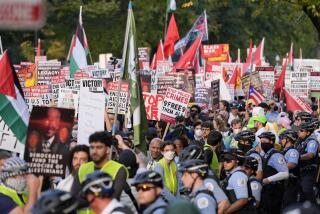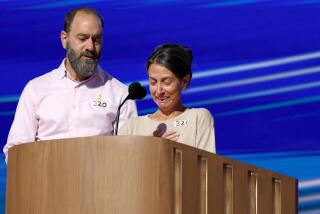Protests Meet a Nimble NYPD
- Share via
NEW YORK — There were two fronts in the battle of wits between police and protesters during the Republican National Convention. One was on the streets, the other on the information superhighway.
Protest organizers used websites and printed fliers to direct thousands of supporters to rallies and marches. But police also were surfing the Web and collecting those same fliers to mobilize their own sizable forces.
In many cases, police arrived at protest sites well before the demonstrators, preempting marches and rallies before they coalesced. Officers used the protesters’ own lines of communication to keep most of them well away from Madison Square Garden, the convention site.
For a week, police and protesters faced off along the fragile boundary between dissent and order in a city traumatized by the Sept. 11 attacks. More than 1,800 people were arrested as law enforcement showed little tolerance for the largely peaceful public gatherings that blocked sidewalks. A spokeswoman said police had not yet determined how many of those arrested had been charged.
The monitoring of information was just one tactic police used to throw protesters off balance and keep a lid on unrest and disruption -- and on free speech, protesters said.
“You can talk all you want about police intelligence, but this was an open secret,” Deputy Police Commissioner Paul J. Browne said. “These guys showed their hand.”
Daryle Lamont Jenkins, a self-described anarchist from a protest coalition called A31, conceded that the need to organize and deploy thousands of followers clashed with the customary anarchist tenets of stealth, disruption and chaos.
“We try to maintain a security culture, but we also have to get the word out,” Jenkins said. “The police will take advantage.”
The New York Police Department deployed 300 scooters that allowed officers to rush to trouble spots. Surveillance cameras mounted on the streets and in some officers’ helmets gave commanders real-time information. Police used metal barriers to control onlookers and orange netting to corral protesters -- and sometimes bystanders -- for arrest. Lawyers and civil libertarians cried foul, saying the NYPD had arrested people who were peacefully exercising their 1st Amendment rights. Many protesters, they said, were not given an opportunity to disperse before being arrested, and some were shoved to the ground or beaten without provocation.
Protesters on bicycles, in particular, said they were arrested while riding down the street. Some arrests were made by officers on mountain bikes -- another tactic used to intercept protesters en route to demonstrations.
“When police swoop in and scoop people off the sidewalk without probable cause, it has a very chilling effect,” said Bill Dobbs of United for Peace and Justice, a coalition of protest groups. “The mayor and the police are essentially criminalizing political dissent.”
Law enforcement officials had negotiated on the spot with organizers as the protesters were gathering, issuing some groups permits to march and rally. But on Tuesday, when anarchists and other protesters planned a day of civil disobedience, police hoodwinked organizers, said Donna Lieberman, executive director of the New York City Civil Liberties Union.
“It was a bait-and-switch tactic,” Lieberman said of the negotiations over an antiwar march near the former World Trade Center site. She said police had agreed to let protesters march, but then corralled 200 and arrested them just as they set off.
“Nonsense -- that didn’t happen,” Browne said, explaining that protesters had failed to abide by an agreement not to block sidewalks and were given ample warnings -- and ample opportunity -- to clear the sidewalks or face arrest.
The march was supposed to end at Madison Square Garden. But police were already on the scene as the marchers assembled -- thanks to website publicity.
Matt Daloisio, an organizer with the War Resisters League, said that police interference had created a bottleneck that blocked sidewalks. Daloisio lodged his complaint as he sat on the pavement on Fulton Street, his hands bound by plastic police cuffs. “We have an administration that believes in preemptive war,” he said. “Now it also believes in preemptive arrests.”
In the end, police and protesters claimed success during the convention week.
The demonstrators received publicity for antiwar, anti-Bush, abortion-rights and pro-labor messages. And on Sunday, protesters mounted what they said was the biggest march ever at an American political convention. “We galvanized thousands of people who say no to the Bush agenda,” Dobbs said.
And the police managed to keep violence and property destruction to a minimum, while helping federal authorities prevent a much greater threat -- a terrorist attack.
“This has been the best-planned police response I’ve seen to a public event in New York, perhaps in the United States,” said Robert McCrie, a professor of security management at John Jay College of Criminal Justice in Manhattan.
Police planned for the convention for about a year. At least 10,000 officers were deployed in and around Madison Square Garden. Officers worked 12-hour shifts daily, giving commanders far more overlapping manpower.
Protesters who had overwhelmed smaller police departments in cities such as Seattle and Miami during violent demonstrations in recent years were not prepared to confront a mobile, 37,000-officer force, Browne said.
Even so, protesters did manage to pierce the rings of security around Madison Square Garden every day of the four-day convention. The most dramatic incursions came Wednesday and Thursday nights, when protesters from a feminist antiwar group called CodePink interrupted prime-time speeches by Vice President Dick Cheney and President Bush.
Medea Benjamin, 51, a CodePink member who was arrested after interrupting a speech by Gov. Arnold Schwarzenegger on Tuesday, said the women had obtained spare convention passes from men they met in bars. The women, who wear flowing pink dresses and nightgowns for protests, wore conservative dresses with American flag lapel pins while sweet-talking the Republicans, Benjamin said.
“You’d be amazed how easy it is to get these passes,” she said. The passes, distributed to delegations, required no accompanying photo ID.
They permitted entry through security checks designed to intercept explosives or weapons.
The fact that protesters were able to penetrate some of the heaviest security in the world should disturb law enforcement authorities, McCrie said.
“That’s an inexcusable security breach,” he said, blaming “lackadaisical Republicans.”
More to Read
Sign up for Essential California
The most important California stories and recommendations in your inbox every morning.
You may occasionally receive promotional content from the Los Angeles Times.











